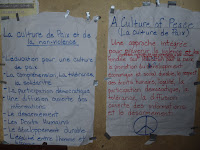For the past 4 months I have been working in Congo with an organization called Sports4HOPE (www.sports4HOPE.org). Sports4HOPE is an organization that seeks to bring about peace and reconciliation to conflict affected areas through sports and peace education. We have been facilitating peace education sessions in 3 communities that were involved in a massacre in 2003. In our recent peace education sessions we have been focusing on human rights education. Human rights education is one of the many fields of peace education that also includes conflict resolution education, disarmament education, critical peace education, multicultural education and environmental education. These sessions on human rights education have proven to be extremely challenging for me because I know and many of our committee members know that Congo has a long way to go in terms of achieving human rights for its citizens. Decades of war, bad governance, and corruption have fueled a lack of respect for human rights and thus created a pessimistic attitude towards the government and its ability or desire to really help its people.
 |
| Peace Education Session in Kagaba |
The government’s lack of respect for human rights was vocally expressed by many of our committee members. This was evident through comments such as, “In Congo, there are no human rights.”, “I do not want to be Congolese because there are too many problems here.”, “You cannot trust the government.”, “The government is lying when it says it has put programs in place to promote human rights.” These are all statements that based on what I have read, seen, heard and understood about Congo; seem to be true, at least to some extent. Given all of the reports of violence during the election, and recent reports we have heard of human rights abuses in the area, it is easy to see why our committee members feel this way.
 |
| Peace Education Activity in Bogoro (The Human Knot) |
As the facilitator I felt challenged to provide some hope and optimism during these sessions for the committee members as well as for myself. No one wants to leave a class feeling depressed and feeling like the situation is so hopeless that there is nothing that can be done. I found myself thinking, it would be much easier to teach this in the US or maybe I will just skip this part of the training so that I do not have to deal with uncomfortable questions or questions that I cannot answer. I am never really sure which way the discussions will go and although I do try to prepare for them as much as I can, I can’t possibly imagine all the potential outcomes of the sessions. Utilizing the Peace Education Program through the Inter-agency Network for Education in Emergencies (INEE http://www.ineesite.org/post/peace_education_programme/) and the Teacher’s Without Borders Curriculum (www.twb.org), I was able to provide the foundations of human rights education as well as activities for our committee members regarding human rights. We discussed how being educated about your rights is only one component of human rights education. Human rights education also focuses on the responsibilities of individuals to stand up for the rights of others. These responsibilities are emphasized in the Universal Declaration of Human Rights but even more so in the African Charter of Human and People’s Rights. Although we can agree that the government in Congo is not doing all that it can and should do, we also have the responsibility as individuals to do what we can and should do.
In the end, the committee members and I did find hope. We found hope in examples of people that have paved the way for us to be where we are today and to make a difference in the world. We found hope in Dr. Martin Luther King Jr. and Gandhi and their non-violent fight for civil rights. We found hope in the fact that today women around the world and in the communities in which we are working have achieved many things that were not possible years ago. We found hope in Synergie Simama, our partnering organization and Kalongo, the director of the organization. Kalongo has dedicated his life to community development and helping to make Congo a better place despite the lack of assistance from the government. We even found hope in Mobuto, the authoritarian leader that ruled Congo for over 30 years. The committee members stated that during Mobuto’s time, there was a sense of nationalism and a spirit of patriotism that focused on being a part of one Congo rather than being divided by tribes and cultures. Most importantly, we found hope in ourselves as individuals and as members of a team working together for change. This is the message that I hope to be able to continue to inspire in the lives of people that I meet as well as my own life.













